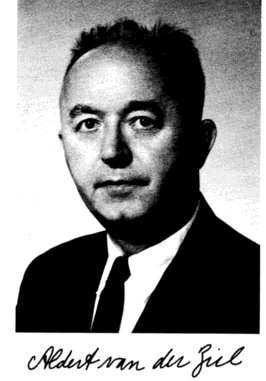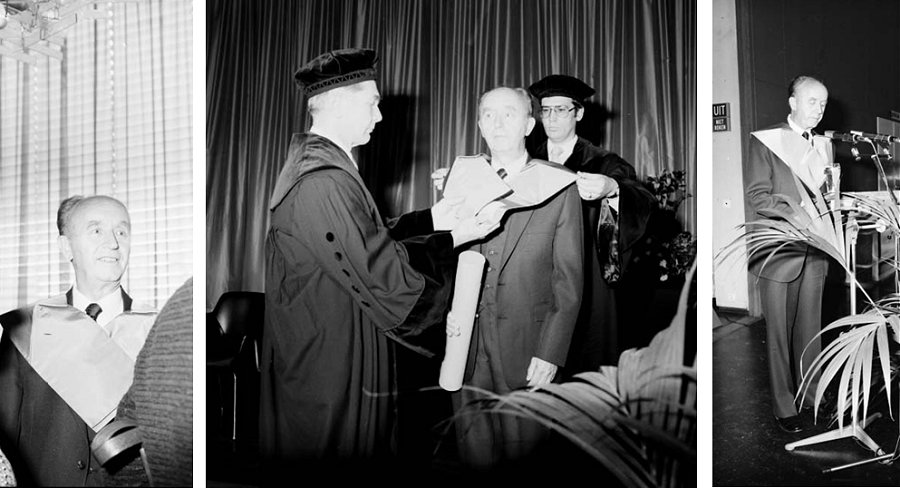

Aldert van der Ziel, professor emeritus of electrical engineering at the University of Minnesota, died on January 20, 1991 at the age of eighty.
Aldert van der Ziel was born in Zandeweer, the Netherlands, on December 12, 1910. He earned a B.A. (1930), M.A. (1933), and Ph.D. (1934) in physics from the University of Groningen, the Netherlands. His Ph.D. thesis topic was written on spectroscopy.
Upon completing his doctoral studies he joined the research staff of the N.V. Philips Gloeilampenfabrieken in Eindhoven, as a research physicist. His tenure at that laboratory continued from 1934 to 1947. In 1947 he emigrated with his family to Canada, where he assumed a post as associate professor of physics at the University of British Colombia in Vancouver. In 1950 he accepted a position as professor of electrical engineering at the University of Minnesota in Minneapolis. He remained on the staff of that department until his retirement in 1980. Dr. van der Ziel served as a graduate research professor at the University of Florida in Gainesville from 1968 until 1989, where he usually spent a trimester per year. He also served as a consultant to a number of industrial companies.
Aldert van der Ziel was a prodigious scholar whose research output in the field of electronic devices began at N.V. Philips and continued up to his last year. He was also a remarkable educator who taught and advised hundreds of students and prospective scientists and engineers until he retired in 1980. After his retirement he continued his research on noise in electronic devices. In his research he supervised nearly eighty doctoral students as well as numerous master’s thesis students. His doctoral students are working in industries and universities in this country and in many foreign countries including China, Korea, Japan, India, and Greece. He was an author of fifteen books and five hundred research papers. A large fraction of these papers were joint with his students; others were either joint with colleagues or alone. Examples of his books are Noise (Prentice Hall, 1959), Solid State Physical Electronics (Prentice Hall, 1958, 1968, and 1975), and Fluctuation Phenomena in Semiconductors (Butterworth, 1959). His last book was Noise in Solid State devices and Circuits (Wiley, 1986).
Van der Ziel emphasized to his students the importance of relating observations to theory and interpretation. He himself recognized that an understanding of the operation of an electronic device was necessary to interpret the observed noise. He also recognized the converse – understanding the observed noise and its dependence on the operating parameter could illuminate the physical process in the device. He was an expert in all electronic devices and published papers on all of those developed in this century up to the present year. These began with vacuum tubes and later covered junction devices, field effect transistors, Josephson junctions, to developments on high electron mobility transistors.
Throughout his career van der Ziel sought fundamental understanding of 1/f noise. In 1980 he examined the possibility of a quantum basis for 1/f noise and carried out experiments that verified this hypothesis and explained his 1/f experiments. He and his students were able to describe the 1/f noise of many modern electronic devices in term of the simple basic quantum 1/f formula. This was presented in a chapter of his last book, Noise in solid State Devices and Circuits.
Although the majority of his publications dealt with noise phenomena, van der Ziel published on quite different fields. An outstanding example of this was his paper on parametric amplification (Journal of Applied Physics, 19(1948) 999-1006) that was a preview of the discovery of the parametric amplifier. This laid the basis for the later invention of the maser and laser amplifiers. In addition to his extraordinary list of publications, his research led to a number of patents, eighteen in all. He served as a member of the editorial board of the journal of Applied Physics for a number of years.
He was elected to the National Academy of Engineering in 1977 and has been the recipient of a number of honors. He was elected a Fellow of the Institute of Electrical and Electronics Engineers (IEEE) in 1956, receiving the Western Electric award of the American Society for Engineering Education in 1967, ASEE’s Vincent Bendix Minorities in Engineering Award in 1975, and the IEEE Education Medal in 1980. He was the recipient of two honorary doctorates, the first from University Paul Sabatier, Toulouse, in 1975, the second from Eindhoven University of Technology in 1981.
Aldert was interested in botany, cosmology, and theology. On the last subject one of his nominators for the Vincent Bendix award observed that, “He has made in addition a meaningful contribution to the dialogue between science and religion, and has taught and written in this demanding area.”
Throughout his research and teaching, Aldert van der Ziel has, directly and through his students, markedly influenced the course of electronic science and technology during his lifetime. His accomplishments will continue to benefit society for the future. He will be missed as a dedicated and caring man.

Aldert van der Ziel when he received his honorary doctorate from the Technical University in Eindhoven the Netherlands in 1981.
(Photograph by kind permission of Technical University Eindhoven)